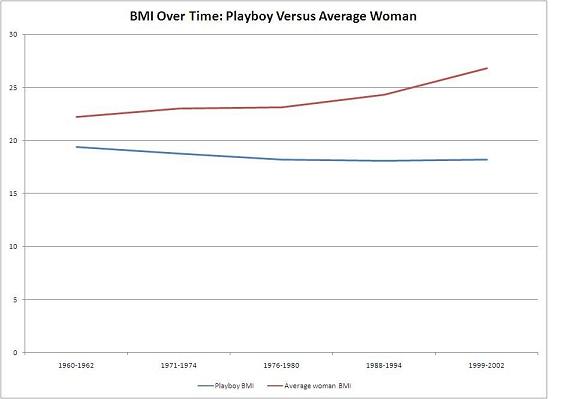Give up? Wired featured a charticle in the February issue on the BMI of Playmates, starting back in 1953 with Marilyn Monroe to the recent January 2009 cover girl, versus those of the average woman. No surprise, the bunnies are trending toward Barbie (who turns 50 this year), while the average woman is slowly crawling up the BMI scale.

BMI, or body mass index, is a a measure of body fat based on height and weight. Playmate BMI data taken from Wired; average women BMIs verified from 2004 CDC article, using data from all females ages 20-29. (Playmates average around age 22, but depending on Hugh's mood can range up into the 30s.)
So, you may be thinking to yourself, are there any potentially associated events that fall on this timeline that could explain these trends? There are - but whether they are truly causual or even remotely associated is the subject for another study.
1959 - Barbie is introduced to the world. Barbie is described as 5'9" and 110 p0unds. Using NIH's BMI calculator, her BMI is 16.2.
Where does that fall along the BMI scale? NIH and CDC provide the following:
< 18.5: underweight
18.5-24.9: normal weight
25.0-29.9: overweight
>30: obese
Obviously Barbie needs to eat a cheeseburger. And after minor adjustments over the decades, Barbie saw a plastic surgeon in 1997 to reduce the size of her hips and bust, and add a few inches to her waist.
 1977 - the cost of importing sugar skyrockets. The more economical choice? High fructose corn syrup. The industrial process had been refined in the late 1960s, allowing greater production. Now you have to look hard to find products that don't have the sweet flavor of obesity.
1977 - the cost of importing sugar skyrockets. The more economical choice? High fructose corn syrup. The industrial process had been refined in the late 1960s, allowing greater production. Now you have to look hard to find products that don't have the sweet flavor of obesity.Although, if you ask the Corn Refiner's Association, a little HFCS never hurt anybody. I wonder if they use the same PR firm as the clean coal advocates.
 Mid-1990s - Friends and Ally McBeal debut. Calista Flockhart makes her way into the hearts and minds of gazillions of American women, but she forgets to make her way into a grocery store. Her BMI during the show? 15.6. Average woman's BMI during the show? Around 26. Gone are the days of Marilyn and Sophia.
Mid-1990s - Friends and Ally McBeal debut. Calista Flockhart makes her way into the hearts and minds of gazillions of American women, but she forgets to make her way into a grocery store. Her BMI during the show? 15.6. Average woman's BMI during the show? Around 26. Gone are the days of Marilyn and Sophia. Meanwhile, the "Rachel shag" is the most-requested haircut - but what about the face shaped by the hair? In Ferris Bueller Jennifer Aniston looked normal, but by the end of Friends she had transformed. Granted, she went on the Zone Diet and now does a lot of yoga.
The women splashed across every magazine cover were thin - where were the curves, the "real" women photos?
Well, even the picture-perfect covers weren't entirely real. Digital enhancement, re-touching, manipulation - it's everywhere. This image is almost scary - the contrast between the "real" version versus the "retouched" version is dramatic. (It reminds me of one of scenes in The Exorcist.) And this magazine cover is fascinating - click on the big orange "unveil the fraud" blurb and take a tour of the changes made to the photo. Another really interesting site is Digital Retouch - explore the links on the bottom right to see alterations in beauty/hair, corrections, and shaping. (Of course, this phenomenon isn't just about women - males get the retouching treatment too. Check out this photo of Conan O'Brian - look at his face before and after retouching.)
2004 - SizeUSA releases results from a two-year study showing fashion designers ignore a woman's real body shape. Most of us don't cut an hourglass figure, embodied by Sophia Loren.
 In fact, only about 8.4 percent of women have that shape, according to the study. Most of us are rather rectangular, followed by spoon shape, with triangular bodies bringing up the rear (no pun intended).
In fact, only about 8.4 percent of women have that shape, according to the study. Most of us are rather rectangular, followed by spoon shape, with triangular bodies bringing up the rear (no pun intended).In 2005, Dove started the Campaign For Real Beauty, using "real" women in ads for its firming collection of products. (I won't go into the irony of patting yourself on the back for using real women in a campaign to make women (a) feel better about themselves by (b) using firming lotion to tone and enhance.)
And in Europe, fashion shows started turning away models because they were too thin.
You could argue that some progress has been made, albeit a rollercoaster of progressing and regressing over the decades. But has it? Consider the contrast between two recent stories involving Lindsay Lohan and Jessica Simpson.
Jessica Simpson has always celebrated her curves, but this photo sent the paps and celebrity obsessed into a frenzy. Some called her fat, others rushed to her defense. But while the left hand was insulting Jessica for being too fat, the right hand was lamenting about poor too-thin Lindsay Lohan.
We can't have it both ways, especially those of us who don't have personal chefs and can barely make it through the day, much less work out for the recommended 30 or 60 or 90 minutes. Can there be a happy medium?




Comments